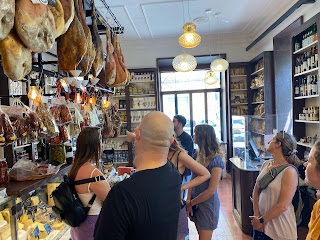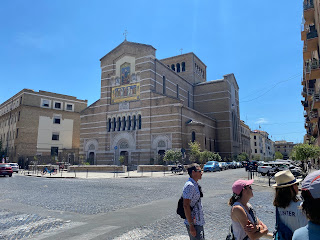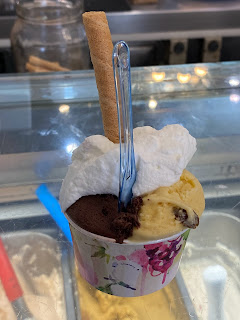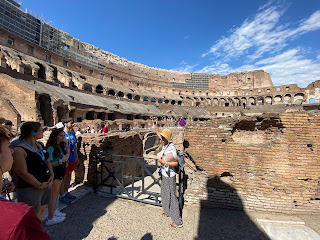I wanted to start Lydia and I off with a nutritious breakfast so that we would have lots of energy to explore Rome.
I don't think I've been to Rome since high school so I was super excited to walk past the Colosseum.
The Victor Emmanuel II National Monument houses Italy's tomb of the unknown soldier.
I used to be kind of annoyed that the church invaded the sacred space of the Pantheon, but it sounds like they are the reason that it has survived in such good condition, so I guess I will allow it.
The text above the columns reads:
M·AGRIPPA·L·F·COS·TERTIVM·FECIT
or in full, "M[arcus] Agrippa L[ucii] f[ilius] co[n]s[ul] tertium fecit," meaning "Marcus Agrippa, son of Lucius, made [this building] when consul for the third time."
Victor Emmanuel II, first king of unified Italy is buried here.
Almost two thousand years after it was built, the Pantheon's dome is still the world's largest unreinforced concrete dome.
We then met up with our food tour guide Nesim Bekalti for some history and some yum yums around town.
Our tour was focused on the Testaccio region of Rome. As you can see the neighborhood is the southernmost of Rome and sits on the Tiber River which leads to the Mediterranean Sea. I think due to this position the region became where are the food shipments came in and were stored.
Due to this Roman culinary history the symbol of Testaccio is the amphora clay vessel that ancient people used to ship foods and drinks.
Nesim is a former chef and so went into crazy detail about how food works and how to make various dishes.
We had initially signed up only for the food portion of the tour, but then I noticed a few other people in our group were getting drinks and I was struck by the thirst. I think we missed a drink at the first place so he started us off with a double fist experience of both red and white wines.
We got a cheese education at Salumeria Volpetti.
We tried very fancy aged balsamic vinegar.
This was fancy oregano that had been allowed to bloom before drying.
It's funny because my concept of Italians is people who would be very strict connoisseurs of pizza, but they have a more expansive concept of pizza than I thought. This is pizza bianca or "white pizza", which is just the crust with no toppings. It was originally just a throwaway tester for a pizza person to ensure the oven was the correct temperature,
Mercato Testaccio was a fun place to go with a guide because it made everything so much more accessible.
They of course found some Roman ruins when digging the foundation for the market building. So one of the benefits of the amphorae clay vessels I mentioned were that they were very cheap to produce. That meant that it wasn't worth the effort to ship them back to where they came from to be refilled with wine or olive oil or whatever. So once they were emptied they were just smashed. Some of the ancient buildings they found here had walls that were constructed from the smashed clay containers.
Our guide told us is a funny former chef way that Rome is an archeological lasagna, and the further down you go the farther back in time you go. People apparently just built buildings on top of the old ones for thousands of years.
He said that he stopped cooking professionally because it was giving him repeated motion injuries like carpal tunnel. That made me sad because I like eating a lot and don't want to wreck people's bodies by making them cook for me.
Our fearless leader sat us down at Mordi e Vai and passed out allesso di scottona con cicoria, which is a magical sandwich consisting of beef from a young childless female cow and some chicory served on ciabatta bread. Lydia said that they reminded her of Lion's Choice, the friggin' St. Louis Arby's ripoff. I feel like I should be giving her the silent treatment or something? That girl don't act right.
He ordered too many so I saved the group by eating one of the extras. It's what Italian heroes do.
Senatus Populusque Romanus!
Nesim sometimes went pretty hard in the paint, and would talk endlessly about the minutiae of choosing food at the market. He talked about how to pick a fresh buffalo mozzarella and how to ask the store owner how old the cheese was and if the answer was more than a day then our chef leader considered that trash. It was a lot.
A more recent period of time had the neighborhood reborn as a center for slaughterhouses and the meat industry. This building has been gentrified into something classier now but its past is betrayed by a statue of a dude wrasslin' a bull. I guess back in the day the poor workers would be paid with the animal's "fifth quarter" meaning the offal. Yucky ducky.
There were lots of public fountains around which I appreciated because I was wrasslin' a thirst. Nesim showed us how to block the faucet with our hand to cause water to come shooting out a hole so I could drink it.
Local landmark Monte Testaccio is a hill made out of, you guessed it, broken Roman food vessels. It covers five city blocks. That is a lot of trash.
The hill got so big that some genius decided to build a restaurant inside of it. That's some meta food container circle of life stuff right there.
There was a area where the clay shards were visible in the walls. There was a gust of cool air coming from the wall which was refreshing. It was starting to get a little toasty out there.
Flavio al Velavevodetto's pasta was so good that I was worried I wouldn't fit back out the door I came in through. Living a life of a Roman pasta cave troll is pretty tempting actually. I believe the top one was carbonara, which was amazing because the meat in it was fried up separately and so was very firm and had a fun crispy texture.
They cooked everything al dente so it was nice an firm when bitten. This was the cacio e pepe. The tour boss said that many of the cheesy or creamy type sauces are from the north of Italy where all of the cows were, and the southern cuisine had more olive oil type sauces. Mr. Chef said that you can use the water you cooked the pasta in as an ingredient in the sauce which mimics creaminess? It sounded like the ramblings of a mad man.
The sad thing about having such a fantastic meal is that now I have to go back to eating the pasta at home, which is pretty sad in comparison.
One fun fact we learned is that the famous laurel wreaths that victorious people wore are actually made of bay leaves. They are still in use and we saw a girl wearing one with her graduation gown.
He also talked about covid as a period of renewal for the Roman food scene, because restaurants that relied on the flood of tourists now had to start making good food again in their absence to bring in locals.
Our tour ended with gelato at Giolitti. They have been doing gelato since 1900 and are keeping it real. Our guide said everything is made with all natural ingredients EXCEPT the mint which had the neon green color. I guess the gelato man has a soft spot for that artificial concoction because it reminds him of his childhood.
We enjoyed our last Testaccio delicacy with an amphora on the wall smiling down on us.
We are crazy people and decided to follow up that long food tour with a long tour without food focused on Roman history. A fun fact is that the Colosseum is actually not the name of the building but a nickname which referred to a giant colossus statue which used to stand nearby. At the time of construction the building's Latin name was simply amphitheatrum, or 'amphitheatre'.
The holes everywhere and from people in later time periods digging out the metal braces that kept the stone blocks together.
It is the largest ancient amphitheatre ever built, and is still the largest standing amphitheatre in the world, despite its age.
I was pretty much getting scorched at this point and took every opportunity to hide in the shade, even if that meant I couldn't hear the tour.
Our guide said that the whole "throwing Christians to the lions" thing was made up. I think there was some sort of a scam going on where the church wanted saints to have died here in order to make the place into a church or something?
Sometime around this point my soul was set on fire by the Italian sun and left my body. This is the Arch of Titus which celebrates Titus Caesar Vespasianus' deification as well as victory in the First Jewish–Roman War. The spoils from the war paid for the construction of the Colosseum.
Flavian Palace
We saw the pope's helicopter.
Antoninus and Faustina Temple
Once we were free of the furnace tour we checked out the Trevi Fountain.
The flagship Gucci store was nearby and we had to give it a look.
I made a small investment. Luckily there was a photo booth thing to capture the moment with the salesmen who helped us.
I got this cool wallet with a kingsnake on it.
I guess salt and tobacco were two goods whose sale was controlled by the government. That is no longer the case but many of the convenience stores around still have the salt reference on their signage.









































































































































No comments:
Post a Comment